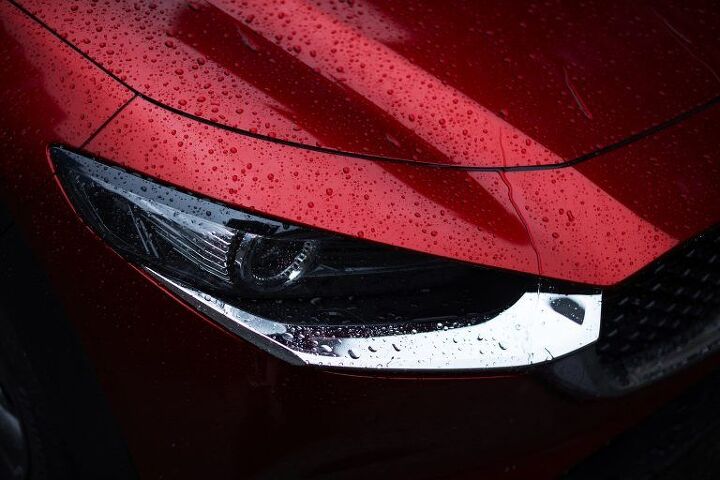Mazda EV Takes Shape Ahead of Tokyo Reveal

Mazda’s upcoming electric vehicle sheds its cloaking in Tokyo on October 23rd, becoming the first mass-market EV from the gas-loving brand. While the automaker hasn’t provided much in the way of details on the model’s layout, the fact that it chose a CX-30 crossover as a test mule for the brand’s in-house-developed powertrain suggests a crossover is on the way.
On Tuesday, the automaker afforded viewers a peek inside the upcoming vehicle.
Promising “a unique sense of openness and connection,” Mazda boasted of the model’s sustainable furnishings, with materials “carefully selected for their unique texture and quality.” Surely this will have TTAC readers salivating at the thought of cork. Yes, there’ll be much cork.
Mazda designers are known for their obsessive focus on harmonious cabin environments, taking great pains in selecting the right materials to compliment a model’s design language. To give the cabin of the small, unnamed EV a sense of openness, Mazda opted for a svelte, floating center console, seen here in a side profile. Clearly, the brand’s sticking with its rotary dial-actuated infotainment system.
In September, Mazda showed off its CX-30-based e-TPV prototype, allowing journos to take the front-drive vehicle for a spin to gauge the tech’s suitability. The powertrain’s output wasn’t overwhelming. A relatively small 35.5 kWh battery pack fueled a single electric motor rated for 141 horsepower and 195 lb-ft of torque. Just the kind of output you’d expect to find in a small EV.
Mazda stressed at the time that the e-TPV was not the production vehicle headed for the Tokyo Motor Show, though it stands to reason that the automaker would go for maximum utility and consumer appeal by opting for a crossover bodystyle. While the vehicle’s battery pack wouldn’t afford the kind of range preferred by American consumers (overseas specs put it at 124 miles), the brand’s range-extender (a rotary engine, disconnected from the drive wheels, that serves as a generator) will help the vehicle go the distance after the battery pack taps out.
We’ll know more about the Mazda EV before long.
[Image: Mazda]

More by Steph Willems
Latest Car Reviews
Read moreLatest Product Reviews
Read moreRecent Comments
- Ajla So a $10K+ transmission repair?
- Kwik_Shift_Pro4X I've mentioned before about being very underwhelmed by the Hornet for a $50000+ all in price tag. Just wasn't for me. I'd prefer a Mazda CX-5 or even a Rogue.
- MaintenanceCosts Other sources seem to think that the "electric Highlander" will be built on TNGA and that the other 3-row will be on an all-new EV-specific platform. In that case, why bother building the first one at all?
- THX1136 Two thoughts as I read through the article. 1) I really like the fins on this compared to the others. For me this is a jet while the others were propeller driven craft in appearance.2) The mention of the wider whitewalls brought to mind a vague memory. After the wider version fell out of favor I seem to remember that one could buy add-on wide whitewalls only that fit on top of the tire so the older look could be maintained. I remember they would look relatively okay until the add-on would start to ripple and bow out indicating their exact nature. Thanks for the write up, Corey. Looking forward to what's next.
- Analoggrotto It's bad enough we have to read your endless Hyundai Kia Genesis shilling, we don't want to hear actually it too. We spend good money on speakers, headphones and amplifiers!



































Comments
Join the conversation
"The powertrain’s output wasn’t overwhelming." Still a Mazda. If they do sell this in the US I expect it will be the slowest BEV in the market.
Spiderman?